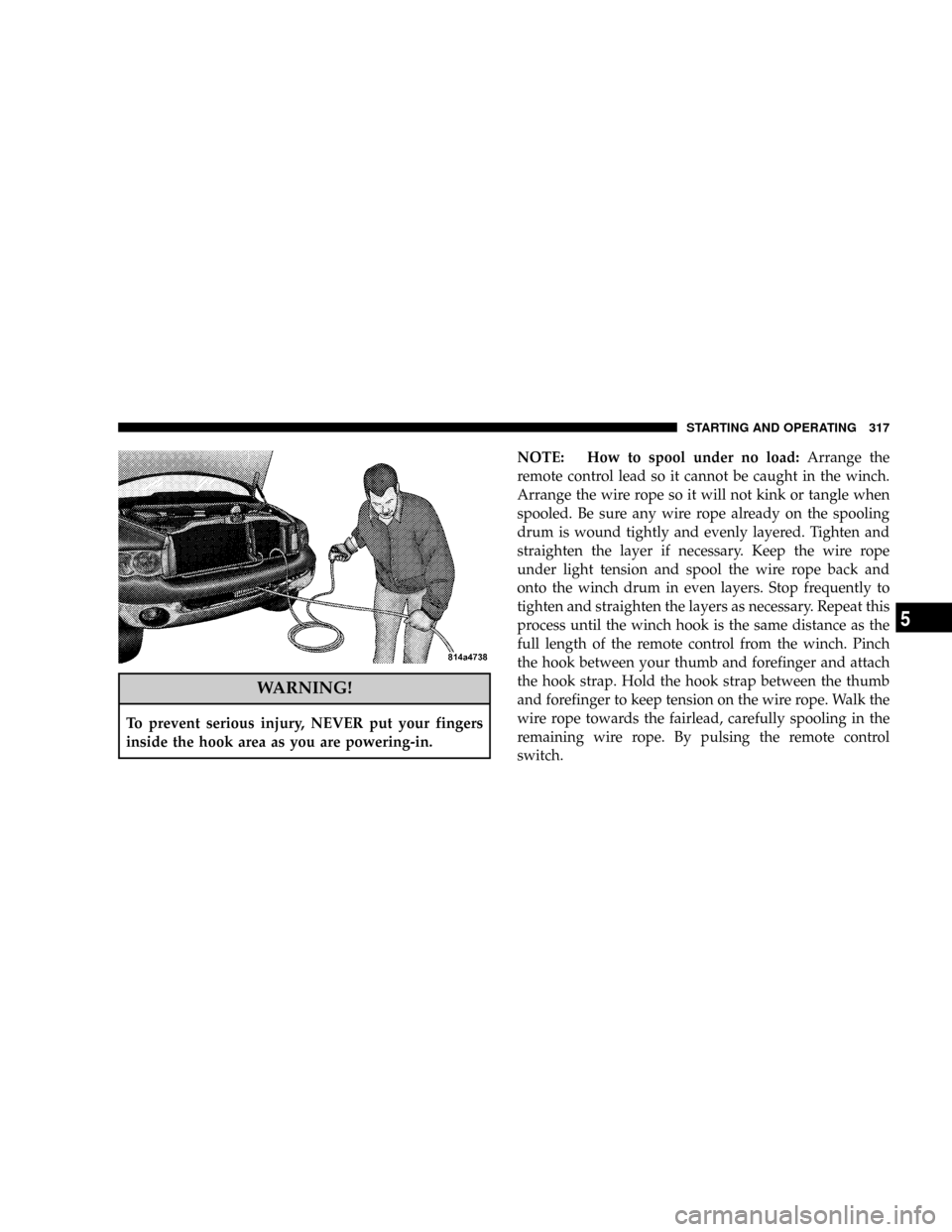DODGE RAM 2500 POWER WAGON 2008 3.G Owners Manual
Manufacturer: DODGE, Model Year: 2008, Model line: RAM 2500 POWER WAGON, Model: DODGE RAM 2500 POWER WAGON 2008 3.GPages: 504, PDF Size: 8.17 MB
Page 311 of 504

6. Secure to the anchor point. Once you've established
your anchor point, secure the tree-trunk protector or
choker-chain around the object.
CAUTION!
Always be certain the anchor you select will with-
stand the load.
Tree Trunk Protector
STARTING AND OPERATING 311
5
Page 312 of 504

NOTE: How to choose an anchor point:A secure
anchor is critical to winching operations. An anchor must
be strong enough to hold while winching. Natural an-
chors include trees, stumps and rocks. Hook the cable as
low as possible. If no natural anchors are available when
recovering another vehicle, your vehicle becomes the
anchor point. In this case, be sure to put the transmission
in neutral, apply the hand brake and block its wheels to
prevent your vehicle from moving. Ideally, you'll want
an anchor point that will enable you to pull straight in the
direction the vehicle will move. This allows the wire rope
to wind tightly and evenly onto the spooling drum. An
anchor point as far away as possible will provide the
winch with its greatest pulling power.
7. Attach the Clevis/D-shackle and Tree Trunk Protector.
Attach the shackle to the two ends of the strap or chain
and through the hook loop, being careful not to over
tighten (tighten and back-off 1/2 turn).8. Lock the clutch. Lock the winch drum by rotating the
clutch lever on the winch to engage.
NOTE:Always ensure the clutch is fully engaged or
disengaged.
Clevis/D-Shackles
312 STARTING AND OPERATING
Page 313 of 504

9. Connect the remote control to the winch control box,
located behind the front bumper. Be careful not to let the
remote control cord dangle in front of the winch. If you
choose to control the winch from inside your vehicle,
always pass the remote through a window to avoid
pinching the cord in the door. Always disconnect the
remote control when not in use.10. Put wire rope under tension. Using the remote con-
trol switch, slowly wind the wire rope until no slack
remains. Once the wire rope is under tension, stand well
clear and never step over it.
11. Check your anchor. Make sure all connections are
secured and free of debris before continuing with the
winching procedure.
STARTING AND OPERATING 313
5
Page 314 of 504

12. Check wire rope. The wire rope should be neatly
wound around the spooling drum. Improper winding
can cause damage to the wire rope.13. In certain situations you
may decide to throw a heavy
blanket or similar object over
the wire rope. A heavy blan-
ket can absorb energy should
the wire rope break. Place it
on the wire rope midway be-
tween the winch and the an-
chor point. Do this before the
wire rope is put under ten-
sion. Do not approach or move the blanket once tension
is applied. Do not allow it to get pulled into the fairlead.
If necessary to move or remove the blanket, slack the
tension on the wire rope first.
14.Establish(no people(zones:Make your intentions
clear. Be sure that everyone in the immediate vicinity
surrounding the winching operation is completely aware
of your intentions before you pull.Declare where the
spectators should not stand - never behind or in front of
314 STARTING AND OPERATING
Page 315 of 504

the vehicle and never near the wire rope or snatch
block. Your situation may have other(no people(zones.
15. Begin winching. With the winching vehicles engine
on and light tension already on the wire rope, begin
winching slowly and steadily. Be sure that the wire rope
is winding evenly and tightly around the spooling drum.For additional assistance, the winched vehicle can be
slowly driven while being pulled by the winch. Continue
pulling until the vehicle is on stable ground. If you are
able to drive the vehicle, the winching operation is
complete.
No People Zones
Using The Remote Control
STARTING AND OPERATING 315
5
Page 316 of 504

NOTE:Avoid overheating the winch motor. For ex-
tended winching, stop at reasonable intervals to allow
the winch motor to cool down.
NOTE: What to look for under load:The wire rope
must always spool onto the drum as indicated by the
drum rotation decal on the winch. As you power-in,
make sure the wire rope winds evenly and tightly on the
drum. This prevents the outer wire wraps from drawing
into the inner wraps, binding and damaging the wire
rope. Avoid shock loads by using the control switch
intermittently to take up wire rope slack. Shock loads can
momentarily far exceed the winch and wire rope ratings.
During side pulls the wire rope tends to stack up at one
end of the drum. This stack can become large enough to
cause serious damage to the winch. So, line up pulls as
straight ahead as possible and stop winching if the wire
rope comes close to the tie rods or mounting plate. To fixan uneven stack, spool out that section of the rope and
reposition it to the opposite end of the drum, which will
free up space for continued winching.
16. Secure vehicle. Once recovery of the vehicle is com-
plete, be sure to secure the vehicle's brakes and put the
transmission in9park9(automatic) or9low9gear for
9manual9transmissions. Release tension in the wire rope.
17. Disconnect wire rope. Disconnect from the anchor.
18. Rewind wire rope. The person handling the wire
rope should walk the rope in and not let it slide through
the hand, control the winch at all times.
316 STARTING AND OPERATING
Page 317 of 504

WARNING!
To prevent serious injury, NEVER put your fingers
inside the hook area as you are powering-in.NOTE: How to spool under no load:Arrange the
remote control lead so it cannot be caught in the winch.
Arrange the wire rope so it will not kink or tangle when
spooled. Be sure any wire rope already on the spooling
drum is wound tightly and evenly layered. Tighten and
straighten the layer if necessary. Keep the wire rope
under light tension and spool the wire rope back and
onto the winch drum in even layers. Stop frequently to
tighten and straighten the layers as necessary. Repeat this
process until the winch hook is the same distance as the
full length of the remote control from the winch. Pinch
the hook between your thumb and forefinger and attach
the hook strap. Hold the hook strap between the thumb
and forefinger to keep tension on the wire rope. Walk the
wire rope towards the fairlead, carefully spooling in the
remaining wire rope. By pulsing the remote control
switch.
STARTING AND OPERATING 317
5
Page 318 of 504

19. Store the hook on the most outboard loop of the tow
hook.
20. Disconnect remote control. Disconnect the remote
control cord from the control box and store in a clean and
dry place. Winching operations are now complete. Put
the cap on the solenoid plug-in.NOTE:Always store the remote control in a protected,
clean, dry area.
RIGGING TECHNIQUES
Various winching situations will require application of
other winching techniques. These could range from too
little distance to achieve maximum pull using straight
line rigging, simply increasing pulling power, or main-
taining a straight-line pulling situation. You will have to
assess what technique is correct for your situation. Think
9safety9at all times.
318 STARTING AND OPERATING
Page 319 of 504

How to change the pulling direction:All winching operations should have a straight line from
the winch to the object being pulled. This minimizes the
wire rope collecting on one side of the drum affecting
pulling efficiency and damaging wire rope. A snatch
block, secured to a point directly in front of the vehicle
will enable you to change your pulling direction while
still allowing the wire rope to be at 90É to wind properly
onto the spooling drum.
Change Pulling Directions
STARTING AND OPERATING 319
5
Page 320 of 504

Increasing pulling power:
In some cases, you may find yourself needing more
pulling power. The use of snatch blocks increases me-
chanical advantage and that increases your pulling
power:
Double Line:
Because pulling power decreases with the number of
layers of wire rope on the winch drum, you can use a
snatch block to double line out more wire rope. This
decreases the number of layers of wire rope on the drum,
and increases pulling power. Start by feeding out enough
wire rope to free the winch hook. Attach the hook to yourIncrease Pulling Power
320 STARTING AND OPERATING